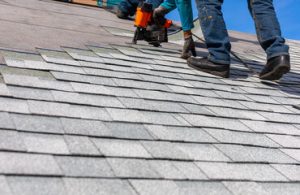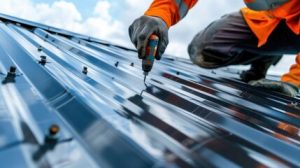A roof’s appearance can make or break a home’s aesthetic. A quality roof installation can last a lifetime and protect your home’s value.

Roofing projects can create a lot of dust and debris. To minimize disruptions, inform your neighbors and cover items in your yard or inside the house with plastic coverings. Contact Roof Installation Massachusetts for professional help.
Roofing underlayment is one of the most important components in your roof system. It serves a number of critical functions, including protecting against moisture and supporting your shingles. Selecting the correct underlayment material and following proper installation techniques protects your home from costly water damage and other issues.
During construction, there may be a period of time between the removal of old roofing materials and the installation of new ones. Roofing underlayment provides a temporary layer of protection to prevent immediate damage from rain, debris and other elements.
There are several different types of underlayment available, each designed to suit a specific climate and roof slope. Asphalt-saturated felt underlayment is a traditional option that balances affordability and performance, and can last up to 30 years with little degradation. Other options like rubberized asphalt provide a more advanced level of waterproofing, resistance to ice dams and other severe weather conditions.
In addition to protecting against moisture, underlayment is also essential for supporting your shingles and preventing damage to the underlying structure of your home. Choosing the right underlayment and maintaining proper ventilation ensures that your shingles remain intact for as long as possible.
To maintain the effectiveness of your underlayment, it is important to regularly check it for signs of wear and tear. Repairing any minor damage quickly will help your underlayment function properly and extend its lifespan. Additionally, ensuring that your attic has adequate ventilation and avoiding blocking any vents will keep moisture from building up inside of your home and damaging underlayment or other areas of the roof system. Finally, removing any fallen branches or other debris that may damage the underlayment will help to protect your roof system.
Ventilation
A well-ventilated roof keeps attic moisture in balance and promotes a healthier indoor environment for property occupants. It prevents mold growth and mildew that can irritate allergies and respiratory conditions, as well as wood rot that may damage the structure of your home or business. Ventilation also helps mitigate soffit and attic insulation problems.
To ensure that the attic and rafter space are adequately ventilated, roofing professionals will install both intake and exhaust vents. Intake vents, which are located at the eaves, allow cool air to enter the attic, while exhaust vents, situated along the ridge of the roof, enable warm air to escape. Intake and exhaust vents should be equally distributed throughout the attic to avoid blocking or restricting air flow.
Proper attic ventilation is crucial for regulating temperature, preventing moisture buildup, and reducing energy costs. Without it, warm air will rise into the living space in summer and be trapped there in winter, forcing your heating or cooling system to work harder to keep your home comfortable.
The proper ventilation of your attic and rafter space also prevents snow from melting on the attic surface and refreezing to form ice dams, which can cause significant and costly structural damage to your home.
Flashing
Flashing is an essential component of your roof and plays a vital role in the structure’s integrity. It seals the points at which a roof changes direction, preventing water from seeping into these areas and damaging the home’s interior. A roof’s flashings are usually made of metal and are installed before shingles and underlayment.
There are several types of flashing. Valley flashing, for example, protects the area where two roof surfaces meet. It is shaped like an uppercase ‘W’ and should be installed before the shingle layer to prevent leaks. Another common type of flashing is ridge cap flashing, which creates a watertight seal at the peak of the roof. Vent pipe flashing, meanwhile, seals the area around plumbing vent pipes that protrude through a roof.
A roof’s gutter apron flashing is also used to prevent water from draining onto other building components, directing it toward the gutter system instead. Another type of flashing, dormer flashing, is installed on dormers, which are projections on a roof that allow for additional headroom in the home.
While flashings are often overlooked, they’re an important part of protecting your home from water damage. It is best to have experienced roofing professionals install your roof flashings to ensure the work is done properly. Choosing the right flashing material and installing it correctly can ensure your roof is waterproof and airtight. By keeping up with routine inspections and repairing damaged flashings promptly, you can keep your home free from moisture-related problems. If you suspect you have a roof problem, contact a professional as soon as possible to avoid extensive damage. They’ll check your roof for problems and provide you with a range of repair options.
Shingles
The shingles of your roof provide a critical first line of defense against the elements. They prevent rain, wind, and snow from penetrating the roof structure and causing costly water damage inside the home. Proper shingle installation is crucial to their effectiveness, as misaligned or loose shingles can blow off during high winds or severe weather conditions.
There are many different shingle options available for homeowners, ranging from the affordable and durable asphalt shingles to the natural beauty and sustainability of wood or composite shingles. Choosing the right option depends on several factors, including local climate and weather patterns, budget, and aesthetic preferences. A roofing professional can assess these factors and recommend the shingle type that best fits your property.
During shingle installation, it’s important to properly inspect and prepare the existing roof. This includes removing damaged shingles, repairing the roof deck, and adding an underlayment. Leaving these steps undone can lead to leaks and other roof issues. Having a professional take care of these tasks ensures that the roof is ready for a new layer of shingles.
The slope or pitch of your roof plays a role in how well the shingles shed water and protect against leaks. A roofer should help you determine the ideal slope for your shingles, based on the shape of your roof and any dormers, valleys, or ridges. In addition, some shingle types are more suitable for certain roof slopes than others. For example, a slate roof carries a sophisticated and timeless look but can be difficult to install on low-sloped roofs and may require special reinforcement. Asphalt shingles, on the other hand, are designed to be compatible with most roof slopes and can typically withstand up to 110-130 mph winds when installed according to manufacturer application guidelines and warranties.
Slate
Slate’s timeless elegance is unsurpassed by other roofing materials. Its beauty enhances your home’s curb appeal and adds a distinct elegance to the neighborhood, while its durability can increase your property value. It also protects your home from storm damage, which is especially important for the hail-prone springs of Connecticut.
Generally, 1 square of slate requires about 89 pieces of 26 by 14 inch (660 by 360 mm) slate. This includes allowances for a 3 inch (75 mm) headlap and a 4 inch (10 mm) eave lap. In steeper roofs or where a greater variety of textures is desired, fewer slates may be required.
When the slope of a roof is steep, a closed valley can be installed where water runoff is a problem. With a closed valley, the slates on both sides of the valley are cut to an angle parallel to the valley center line and butted together, forming a mitered joint. Open valleys are also available where water runoff is not a concern. In either type of valley, it is important to install metal flashing between the slates and the roof sheathing for added protection against leakage.
Other penetrations such as plumbing soil stacks, vents, furnace or water heater flue pipes and electrical standpipes must be flashed. The flashing consists of some type of flat flange mounted over the slate and fastened to the sheathing with a neoprene or rubber gasket.
A double layer underlayment system is required where slate is installed over existing wood sheathing. In addition to a water-resistant, polymer-modified bitumen underlayment, a minimum of two layers of No. 30 asphalt-saturated felt should be placed at a minimum of a 19 inch (480 mm) overlap. The underlayment should be fastened securely enough to hold it in place until the primary roof covering material is applied.
